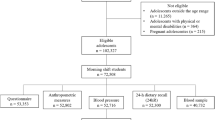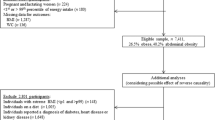Abstract
Background/objective
In recent decades, changes in the diet of Brazilians have been characterized by increased consumption of high energy-dense foods, rich in fat and sugar. This study was aimed at assessing diet quality based on the intake of foods with high content of solid fat and added sugars (SoFAS).
Subjects/methods
The first Brazilian National Dietary Survey (2008–2009) is a nationwide representative cross-sectional study that collected food records from 34,003 ≥ 10-year-old individuals. A receiver-operating characteristic curve was used to determine the limit that would identify diets with high SoFAS content.
Results
The limit of 45% of total dietary energy provided by SoFAS was adopted to classify diets with excessive content. The SoFAS provided 53% of daily energy intake to adolescents, 49% to adults, and 48% to the elderly. A high intake of SoFAS was found in 64.7% of adolescents, 59.1% of adults, and 57.8% of the elderly. The contribution of SoFAS to daily energy intake increased with income in all age groups. Those with high consumption of SoFAS had higher intakes of sugar-sweetened beverages, cookies and cakes, processed meats, chips, candy and chocolate, and sandwiches and snacks, when compared with those that had moderate SoFAS intake (<45% of daily energy).
Conclusions
The 45% cutoff point for the contribution of SoFAS foods to total energy intake, utilized to classify low-quality diets, allowed to point out the high-risk profile of the Brazilian diet.
This is a preview of subscription content, access via your institution
Access options
Subscribe to this journal
Receive 12 print issues and online access
$259.00 per year
only $21.58 per issue
Buy this article
- Purchase on Springer Link
- Instant access to full article PDF
Prices may be subject to local taxes which are calculated during checkout
Similar content being viewed by others
References
Souza AM, Pereira RA, Yokoo EM, Levy RB, Sichieri R. Most consumed foods in Brazil: National Dietary Survey 2008–2009. Rev Saude Publica. 2013;47:S190–9.
Souza RAG, Yokoo EM, Sichieri R, Pereira RA. Energy and macronutrient intakes in Brazil: results of the first nationwide individual dietary survey. Public Health Nutr. 2015;24:1–10.
Malta DC, Sardinha LM, Mendes I, Barreto SM, Giatti L, Castro IR, et al. Prevalence of risk health behavior among adolescents: results from the 2009 National Adolescent School-based Health Survey (PeNSE). Cienc Saude Coletiva. 2010;15:S3009–19.
Araujo MC, Bezerra IN, Barbosa FS, Junger WL, Yokoo EM, Pereira RA, et al. Macronutrient consumption and inadequate micronutrient intake in adults. Rev Saude Publica. 2013;47:S177–89.
Pereira RA, Duffey KJ, Sichieri R, Popkin BM. Sources of excessive saturated fat, trans fat and sugar consumption in Brazil: an analysis of the first Brazilian nationwide individual dietary survey. Public Health Nutr. 2014;17:113–21.
Martins AP, Levy RB, Claro RM, Moubarac JC, Monteiro CA. Increased contribution of ultra-processed food products in the Brazilian diet (1987–2009). Rev Saude Publica. 2013;47:656–65.
Biro FM, Wien M. Childhood obesity and adult morbidities. Am J Clin Nutr. 2010;91:1499–505.
Silva FM, Giatti L, de Figueiredo RC, Molina MDCB, de Oliveira Cardoso L, Duncan BB, et al. Consumption of ultra-processed food and obesity: cross sectional results from the Brazilian Longitudinal Study of Adult Health (ELSA-Brasil) cohort (2008–2010). Public Health Nutr. 2018;12:1–9.
Rooney BL, Mathiason MA, Schauberger CW. Predictors of obesity in childhood, adolescence, and adulthood in a birth cohort. Matern Child Health J. 2011;15:1166–75.
Cornwell B, Villamor E, Mora-Plazas M, Marin C, Monteiro CA, Baylin A. Processed and ultra-processed foods are associated with lower-quality nutrient profiles in children from Colombia. Public Health Nutr. 2018;21:142–7.
Previdelli AN, Andrade SC, Pires MM, Vívolo SRF, Fisberg RM, Marchioni DML. A revised version of the Healthy Eating Index for the Brazilian population. Rev Saude Publica. 2011;45:794–8.
Rauber F, da Costa Louzada ML, Steele EM, Millett C, Monteiro CA, Levy RB. Ultra-processed food consumption and chronic non-communicable diseases-related dietary nutrient profile in the UK (2008–2014). Nutrients. 2018;10:e587.
Carvalho KMBD, Dutra ES, Pizato N, Gruezo ND, Ito MK. Diet quality assessment indexes. Rev Nutr. 2014;27:605–17.
Moeller SM, Reedy J, Millen AE, Dixon LB, Newby PK, Tucker KL, et al. Dietary patterns: Challenges and opportunities in dietary patterns research. An experimental biology workshop, April 1, 2006. J Am Diet Assoc. 2007;107:1233–9.
IBGE - Instituto Brasileiro de Geografia e Estatística. Pesquisa de Orçamentos Familiares, 2008–2009: Tabelas de Composição Nutricional dos Alimentos Consumidos no Brasil. Rio de Janeiro: Instituto Brasileiro de Geografia e Estatística; 2011.
Nutrition Coordination Center. Nutrition data system for research—NDSR. Minneapolis, MN: University of Minnesota; 2008.
US Department of Agriculture (USDA) Report of the Dietary Guidelines Advisory Committee on the dietary guidelines for Americans: to the Secretary of Agriculture and the Secretary of Health and Human Services. Washington, DC: USDA and US DHHS; 2010.
World Health Organization. Diet, nutrition and the prevention of chronic diseases. Joint WHO/FAO expert consultation. Geneva: WHO; 2003. WHO Technical Report Series no. 916.
de Onis M, Onyango AW, Borghi E, Siyam A, Nishida C, Siekmann J. Development of a WHO growth reference for school-aged children and adolescents. Bull World Health Org. 2007;85:660–7.
World Health Organization. Obesity: preventing and managing the global epidemic: report of a WHO Consultation. Geneva: WHO; 1998. WHO Technical Report Series no. 894.
Lipschitz DA. Screening for nutritional status in the elderly. Prim Care. 1994;21:55–67.
Pearce N. Effect measures in prevalence studies. Environ Health Perspect. 2004;112:1047–50.
Fisberg RM, Marchioni DML, Verjy-Jr E, Araujo MC, Bezerra IN, Pereira RA, et al. Inadequate nutrient intake among the Brazilian elderly: National Dietary Survey 2008–2009. Rev Saude Publica. 2013;47:S222–30.
Veiga GV, Costa RS, Araújo MC, Souza AM, Bezerra IN, Barbosa FS, et al. Inadequate nutrient intake in Brazilian adolescents. Rev Saude Publica. 2013;47:S212–21.
Bielemann RM, Motta JVS, Minten GC, Horta BL, Gigante DP. Consumption of ultra-processed foods and their impact on the diet of young adults. Rev Saude Publica. 2015;49:28.
Monteiro LS, Rodrigues PR, Veiga GV, Marchioni DML, Pereira RA. Diet quality among adolescents has deteriorated: a panel study in Niterói, Rio de Janeiro State, Brazil, 2003-2008. Cad Saude Publica. 2016;32:e00124715.
Reedy J, Krebs-Smith SM. Dietary sources of energy, solid fats, and added sugars among children and adolescents in the United States. J Am Diet Assoc. 2010;110:1477–84.
Louzada MLC, Martins AP, Canella DS, BaraldiI LG, Levy RB, Claro RM, et al. Ultra-processed foods and the nutritional dietary profile in Brazil. Rev Saude Publica. 2015;49:38.
Morin JP, Rodríguez-Durán LF, Guzmán-Ramos K. Palatable hyper-caloric foods impact on neuronal plasticity. Front Behav Neurosci. 2017;11:19.
World Health Organization (WHO). Report of the commission on ending childhood obesity. Genebra: World Health Organization; 2016.
Alvarez MM, Vieira ACR, Moura AS, da Veiga GV. Insulin resistance in brazilian adolescent girls: association with overweight and metabolic disorders. Diab Res Clin Pract. 2006;74:183–8.
Bray GA, Popkin BM. Dietary sugar and body weight: have we reached a crisis in the epidemic of obesity and diabetes?: health be damned! Pour on the sugar. Diabetes Care. 2014;37:950–6.
Jabs J, Devine CM. Time scarcity and food choices: an overview. Appetite. 2006;47:196–204.
Costa CS, Flores TR, Wendt A, Neves RG, Assunção MCF, Santos IS. Sedentary behavior and consumption of ultraprocessed foods by Brazilian adolescents: Brazilian National School Health Survey (PeNSE), 2015. Cad Saúde Pública. 2018;34:e00021017.
Mallarino C, Gómez LF, González-Zapata L, Cadena Y, Parra DC. Advertising of ultra-processed foods and beverages: children as a vulnerable population. Rev Saúde Pública. 2013;47:1006–10.
Monteiro CA, Levy RB, Claro RM, Castro IRR, Cannon G. A new classification of foods based on the extent and purpose of their processing. Cad Saude Publica. 2010;26:2039–49.
Maillot M, Drewnowski A. Energy allowances for solid fats and added sugars in nutritionally adequate US diets estimated at 17–33% by a linear programming model. J Nutr. 2011;141:333–40.
Levy RB, Claro RM, Bandoni DH, Mondini L, Monteiro CA. Availability of added sugars in Brazil: distribution, food sources and time trends. Rev Bras Epidemiol. 2012;15:3–12.
Subar AF, Kipnis V, Troiano RP, Midthune D, Schoeller DA, Bingham S. Using intake biomarkers to evaluate the extent of dietary misreporting in a large sample of adults: the OPEN study. Am J Epidemiol. 2003;158:1–13.
Ferreira APS, Szwarcwald CL, Damacena GN. Prevalence of obesity and associated factors in the Brazilian population: a study of data from the 2013 National Health Survey. Rev Bras Epidemiol. 2019;22:E190024.
Nicklas TA, O’Neil CE. Development of the SoFAS (solid fats and added sugars) concept: the 2010 dietary guidelines for Americans. Adv Nutr. 2015;6:S368–75.
Britten P, Cleveland LE, Koegel KL, Kuczynski KJ, Nickols-Richardson SM. Impact of typical rather than nutrient-dense food choices in the US department of agriculture food patterns. J Acad Nutr Diet. 2012;112:1560–9.
Funding
This work was supported by the National Council for Scientific and Technological Development (CNPq—Process 480296/2007-3).
Author information
Authors and Affiliations
Contributions
LSM and PRMR contributed to data analysis and interpretation and paper writing. RS contributed to data interpretation and paper revision. RAP contributed to the conception and design of this study, data analysis and interpretation, and paper writing and critical revision.
Corresponding author
Ethics declarations
Conflict of interest
The authors declare that they have no conflict of interest.
Additional information
Publisher’s note Springer Nature remains neutral with regard to jurisdictional claims in published maps and institutional affiliations.
Rights and permissions
About this article
Cite this article
Monteiro, L.S., Rodrigues, P.R.M., Sichieri, R. et al. Intake of saturated fat, trans fat, and added sugars by the Brazilian population: an indicator to evaluate diet quality. Eur J Clin Nutr 74, 1316–1324 (2020). https://doi.org/10.1038/s41430-020-0582-y
Received:
Revised:
Accepted:
Published:
Issue Date:
DOI: https://doi.org/10.1038/s41430-020-0582-y



